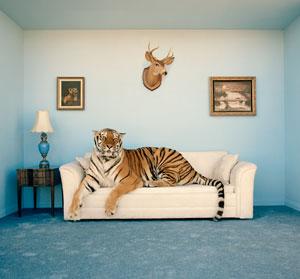 Since the exotic animal incident in Zanesville, Ohio a few weeks ago, I have received a lot of questions regarding the laws governing exotic animal ownership in the United States. Ownership of exotic or non-native species in the US is a much debated subject. In actuality, regulation is done on a state, not national, basis; which allows for a lot of inconsistencies and what appears to be very little regulation. On one side of the argument are those individuals who own exotic species and want to continue to do so. On the other side are people who want to regulate or even ban ownership of any potentially dangerous animals. And then there are those who are just now realizing that they may be closer to a 150 kg (300 lb) male African lion than they want.
Since the exotic animal incident in Zanesville, Ohio a few weeks ago, I have received a lot of questions regarding the laws governing exotic animal ownership in the United States. Ownership of exotic or non-native species in the US is a much debated subject. In actuality, regulation is done on a state, not national, basis; which allows for a lot of inconsistencies and what appears to be very little regulation. On one side of the argument are those individuals who own exotic species and want to continue to do so. On the other side are people who want to regulate or even ban ownership of any potentially dangerous animals. And then there are those who are just now realizing that they may be closer to a 150 kg (300 lb) male African lion than they want.
State regulations fall into one of five categories: 1. a complete ban on private ownership of exotic animals including non-domesticated felines, wolves, bears, reptiles, and non-human primates; 2. partial ban on private ownership of some exotic animals (ownership precludes previously mentioned species); 3. a license or permit is required by the owner as a way to register the animal with local and state authorities; 4. no license or permit required to register the animal with authorities, but there may be other regulation regarding transportation or veterinary related; or 5. no statue or regulation. Of the 50 states, 20 have a complete ban, 8 partial ban, 12 license and permit required, 9 no license and permit required, but other regulations may apply, and 2 (West Virginia and Wisconsin) do not have any laws governing exotic animal ownership.
wolves, bears, reptiles, and non-human primates; 2. partial ban on private ownership of some exotic animals (ownership precludes previously mentioned species); 3. a license or permit is required by the owner as a way to register the animal with local and state authorities; 4. no license or permit required to register the animal with authorities, but there may be other regulation regarding transportation or veterinary related; or 5. no statue or regulation. Of the 50 states, 20 have a complete ban, 8 partial ban, 12 license and permit required, 9 no license and permit required, but other regulations may apply, and 2 (West Virginia and Wisconsin) do not have any laws governing exotic animal ownership.
 So just how many animals are in private ownership in the US? Because of the lack of consistency in regulation, it is nearly impossible to determine how many exotic species are privately owned; estimates are as high as 20.3 million individuals. Currently, there are over 13 million reptiles including snakes (venomous and non-venomous), crocodilians, and lizards housed in private residences. Some venomous snakes like cobras and rare pit vipers can command a price of over $10,000 per individual; this enables exotic pet breeding and propagates the exotic animal trade. Second only to reptiles, large carnivores are very popular among exotic animal owners with ~15,000 big cats, ~2,000 bears, and ~1,000 wild canids living in homes across the nation. In addition, it is estimated that 15,000 non-human primates live as exotic pets.
So just how many animals are in private ownership in the US? Because of the lack of consistency in regulation, it is nearly impossible to determine how many exotic species are privately owned; estimates are as high as 20.3 million individuals. Currently, there are over 13 million reptiles including snakes (venomous and non-venomous), crocodilians, and lizards housed in private residences. Some venomous snakes like cobras and rare pit vipers can command a price of over $10,000 per individual; this enables exotic pet breeding and propagates the exotic animal trade. Second only to reptiles, large carnivores are very popular among exotic animal owners with ~15,000 big cats, ~2,000 bears, and ~1,000 wild canids living in homes across the nation. In addition, it is estimated that 15,000 non-human primates live as exotic pets.
There are literally thousands of groups supporting exotic animal ownership. Private owners argue that exotic animals are no more dangerous than a domestic dog. The majority of organizations acknowledge that there are those individuals that should not be allowed to keep exotic species because they either cannot properly care for them or they only have these species to participate in the illegal black market trade in wildlife or wildlife parts. However, it is suggested that these are isolated incidences and do not represent exotic owners as a whole. Furthermore, exotic animal owners love their pets and think of them as a member of the family.
domestic dog. The majority of organizations acknowledge that there are those individuals that should not be allowed to keep exotic species because they either cannot properly care for them or they only have these species to participate in the illegal black market trade in wildlife or wildlife parts. However, it is suggested that these are isolated incidences and do not represent exotic owners as a whole. Furthermore, exotic animal owners love their pets and think of them as a member of the family.
 Groups against private ownership claim that dangerous animals have no place in private homes, and are a danger to not only the owners, but the entire “neighborhood.” Exotic, non-native species can inflict physical injury, act as carriers of zoonotic diseases, and destroy habitat. In the last 20 years, over 100 human deaths and 2000 injuries are the direct result of exotic species; in almost all cases of physical injury large carnivores or non-human primates have been involved. Moreover, conservation groups against private exotic animal ownership claim that this practice is selfish and does nothing for species preservation or public education; most incidences result in a greater fear and hatred. For example, in the wild, the 6 remaining subspecies of tiger are all considered critically endangered with less than 5,000 individuals
Groups against private ownership claim that dangerous animals have no place in private homes, and are a danger to not only the owners, but the entire “neighborhood.” Exotic, non-native species can inflict physical injury, act as carriers of zoonotic diseases, and destroy habitat. In the last 20 years, over 100 human deaths and 2000 injuries are the direct result of exotic species; in almost all cases of physical injury large carnivores or non-human primates have been involved. Moreover, conservation groups against private exotic animal ownership claim that this practice is selfish and does nothing for species preservation or public education; most incidences result in a greater fear and hatred. For example, in the wild, the 6 remaining subspecies of tiger are all considered critically endangered with less than 5,000 individuals collectively still alive. A large number of the tigers in the private ownership are hybrids as a result from matings between different subspecies or even with lions. In addition, non-native species that are illegally released or escape can wreak havoc on an ecosystem. Large snakes such as Burmese and reticulated pythons and boa constrictors have been found by the thousands in Florida’s Everglades National Park. These introduced reptiles are killing native fauna and out-competing other top predators for prey.
collectively still alive. A large number of the tigers in the private ownership are hybrids as a result from matings between different subspecies or even with lions. In addition, non-native species that are illegally released or escape can wreak havoc on an ecosystem. Large snakes such as Burmese and reticulated pythons and boa constrictors have been found by the thousands in Florida’s Everglades National Park. These introduced reptiles are killing native fauna and out-competing other top predators for prey.
 Regardless of where you stand on the issue of exotic animal ownership, I think everyone agrees that more regulation is needed. In the wake of the recent tragedy in Ohio, it is obvious there is a greater need for improved legislation. Even in states that require permits and licenses, for every one exotic animal that is registered, it is likely there are ten that are not. Owners must be willing to take responsibility and accept stiffer regulations to ensure safety for humans, animals, and environment. On the other hand, why would someone want such a dangerous “pet” other than for selfish reasons? Would not a domestic dog or cat serve as a worthy companion? Wild animals are just that, wild. If you truly love a species like a tiger or lion, why not put forth your efforts to conserve the species within its natural environment and preserve and safeguard habitat?
Regardless of where you stand on the issue of exotic animal ownership, I think everyone agrees that more regulation is needed. In the wake of the recent tragedy in Ohio, it is obvious there is a greater need for improved legislation. Even in states that require permits and licenses, for every one exotic animal that is registered, it is likely there are ten that are not. Owners must be willing to take responsibility and accept stiffer regulations to ensure safety for humans, animals, and environment. On the other hand, why would someone want such a dangerous “pet” other than for selfish reasons? Would not a domestic dog or cat serve as a worthy companion? Wild animals are just that, wild. If you truly love a species like a tiger or lion, why not put forth your efforts to conserve the species within its natural environment and preserve and safeguard habitat?
